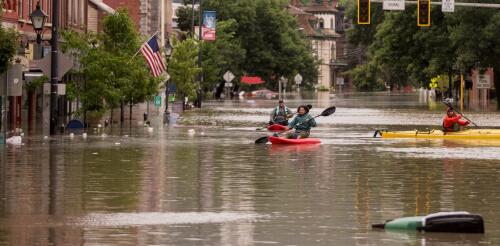Climate change
Coast redwoods – enormous, spectacular trees, some reaching nearly 400 feet, the tallest plants on the planet – thrive mostly in a narrow strip of land in the Pacific Northwest of the United States. Most of them grow from southern Oregon down into northern California, snugged up against the rugged Pacific coast. They have grown by slowly responding to moisture and rich alluvial soil over millennia, combined with a genetic payload that pushes them to the upper limits of tree height. They are at risk – down to perhaps 70,000 individuals, falling from at least a half-million trees before humans arrived – but that’s not a new story, for we are all at risk. Redwoods, like all trees, are engineered marvels. People don’t tend to think of natural things as “structures,” leaving that term to stand in for buildings, bridges and dams. But although trees were not built by humans, they didn’t just happen. They have come into their own t...
The year 2023 was marked by extraordinary heat, wildfires and weather disasters. In the U.S., an unprecedented heat wave gripped much of Texas and the Southwest with highs well over 100 degrees Fahrenheit (37.8 Celsius) for the entire month of July. Historic rainfall in April flooded Fort Lauderdale, Florida, with 25 inches of rain in 24 hours. A wave of severe storms in July sent water pouring into cities across Vermont and New York. Another powerful system in December swept up the Atlantic coast with hurricane-like storm surge and heavy rainfall. The West Coast started and ended the year with flooding and mudslides from atmospheric rivers, and California was hit in August by a tropical storm – an extremely rare event there. Wildfires ravaged Hawaii, Louisiana and several other states. And Canada’s worst fire season on record sent thick smoke across large parts of North America. A person walks through a scene of destructio...
Reading down the lengthy final agreement of the COP28 United Nations climate conference held in December 2023, you’ll go a long way before finding a strong, active verb. The lengthy recitation of climate impacts “notes with concern” and occasionally with “significant concern” glaring gaps in countries’ current policies. But while countries volunteered pledges to act, they were less keen to have those pledges framed as binding agreements in the final text. Reactions to COP28’s conclusion have been understandably mixed. Going into the talks, the world was more on track to avert catastrophic warming than it would have been without the 2015 Paris Agreement, but a long way from where it needs to be. Even if all the pledges made at COP28 are implemented, the world will still exceed the Paris goal of keeping global warming under 1.5 degrees Celsius (2.7 Fahrenheit) compared to preindustrial temperatures....
A lot can go wrong in a large urban water system. Pumps malfunction. Valves break. Pipes leak. Even when the system is functioning properly, water can sit in pipes for long periods of time. Water shortages are also a growing problem in a warming world, as communities across the Southwestern U.S. and in many developing nations are discovering. That’s why cities have started experimenting with small-scale alternatives – including wastewater recycling and localized water treatment strategies known as decentralized or distributed systems. I study large- and small-scale water systems, focusing on innovative system designs that allow local use of water sources that might otherwise go to waste. As technology improves, cities are discovering something that rural communities have long known: Small-scale water treatment, properly engineered, can be cheaper and easier to maintain than a centralized system, and it can improve water security and even the environment. Cleaning w...
Tropical forest landscapes are home to millions of Indigenous peoples and small-scale farmers. Just about every square meter of land is spoken for, even if claims are not formally recognized by governments. These local landholders hold the key to a valuable solution as the world tries to slow climate change – restoring deforested tropical landscapes for a healthier future. Tropical forests are vital to Earth’s climate and biodiversity, but a soccer field-size area of mature tropical forest is burned or cut down about every 5 seconds to clear space for crops and cattle today. While those trees may be lost, the land still has potential. Tropical forests’ combination of year-round sunshine and high rainfall can lead to high growth rates, suggesting that areas where tropical forests once grew could be valuable sites for reforestation. In fact, a host of international agreements and declarations envision just this. The Worl...




